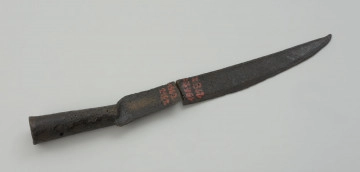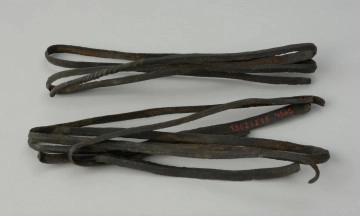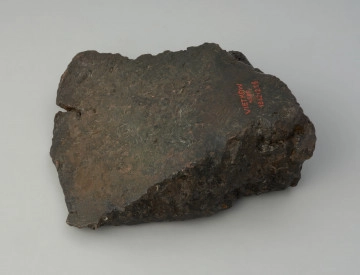
A knife with a sleeve handle
around 900 p.n.e. — 750 p.n.e.
National Museum in Szczecin
Part of the collection: Bronze Age
The impressive, relatively long and slender bronze axe is decorated with horizontal ribbing with fine notches. A certain lightness is given to it by the faceting of both sides. Axes with a socket usually served as tools, as is confirmed by the traces preserved on the wood from the Biskupin stronghold. They could also have been used as weapons. It is indicated by the furnishings of men's graves, where axes co-occurred with other weapons but never with tools. The object dating to the 5th period of the Bronze Age (c. 900-750 BC) was discovered at the end of the 19th century in a large hoard comprising fifteen axes of the same type, eight axes with wings, weapons, body ornaments and clothing, elements of horse harness and items related to metallurgy and foundry work. The deposit was discovered at a depth of only 15 cm below the surface of a flooded meadow belonging to Mr August Schiewer. All bronze objects were placed in a substantial earthenware vessel next to a large stone. The type of the presented axe originates from the Nordic culture. It is abundant in northern Germany, Denmark, and Sweden. In Poland, it is a very rare find. Only five specimens are known from Pomerania and Greater Poland, including three from the Witkowo hoard.
Dorota Kozłowska
Author / creator
Dimensions
the entire object: height: 12 cm, width: 5 cm
Object type
axe
Technique
casting
Material
bronze
Origin / acquisition method
legal transfer
Creation time / dating
Creation / finding place
Owner
National Museum in Szczecin
Identification number
Location / status

around 900 p.n.e. — 750 p.n.e.
National Museum in Szczecin

around 900 p.n.e. — 750 p.n.e.
National Museum in Szczecin

around 900 p.n.e. — 750 p.n.e.
National Museum in Szczecin
DISCOVER this TOPIC
Castle Museum in Łańcut
DISCOVER this PATH
Educational path